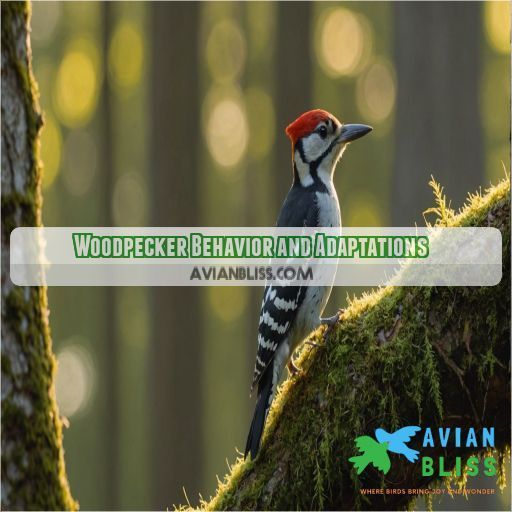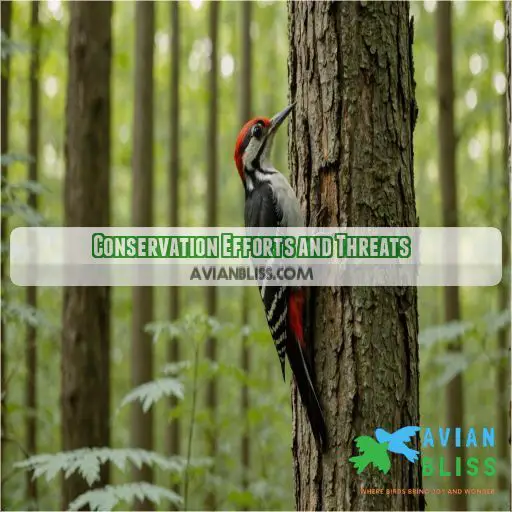This site is supported by our readers. We may earn a commission, at no cost to you, if you purchase through links.

Kentucky’s woodpeckers are a fascinating bunch, with seven species that’ll keep you on your toes.
You’ll spot the Red-headed Woodpecker thriving in open woodlands, the Downy Woodpecker drumming away on dead trees, and the Pileated Woodpecker making itself at home in large, dead trunks.
From the Red-bellied Woodpecker‘s short-distance migrations to the Yellow-bellied Sapsucker‘s sap-sipping habits, each species has its unique quirks.
As you explore Kentucky’s diverse woodpecker population, you’ll discover the intricate details of their habitats, behaviors, and adaptations – and we’re just tapping into the surface!
Table Of Contents
Key Takeaways
- Meet the ultimate drumming masters of the Bluegrass State! Kentucky is home to seven fascinating woodpecker species, each with its own quirks and habits – get ready to spot the Red-headed Woodpecker, Downy Woodpecker, and Pileated Woodpecker, among others, and be amazed by their remarkable adaptations!
- Habitat, habitat, habitat – it’s all about the right trees, folks! Woodpeckers in Kentucky are picky about their homes, often choosing trees with specific features like tree cavities, nesting heights, and branch structures, so preserving large tracts of forest and restoring connectivity between fragmented areas is key to supporting these incredible birds.
- Climate change is no laughing matter, especially for Kentucky’s woodpeckers! Rising temperatures are impacting their food availability, nesting site changes, and even disease risk – it’s up to us to support conservation efforts and reduce our carbon footprint to protect these magnificent creatures and their habitats.
- Want to be a woodpecker hero? Plant native trees in your backyard, reduce pesticide use, and set up bird-friendly feeders with suet or seeds to attract these drumming masters – every small action helps, and with a little practice and patience, you’ll be a pro at spotting and identifying Kentucky’s incredible woodpeckers in no time!
Kentucky’s Woodpecker Species
You’re about to enter the fascinating world of Kentucky’s woodpeckers, where seven amazing species are waiting to be discovered, each with their unique characteristics, behaviors, and habitats (Source). From the striking Red-headed Woodpecker to the tiny Downy Woodpecker, you’ll get to know the woodpeckers that call Kentucky home and learn how to spot them in their natural habitats .
Red-headed Woodpecker Habitat and Diet
In Kentucky, the Red-headed Woodpecker‘s habitat consists of open woodlands, savannas, and dead timber in swamps (Source). They thrive on a diet rich in insects, nuts, and fruits . With a declining population, conservation efforts are necessary to protect their nesting preferences and food sources . Let’s explore ways to support these magnificent birds in the Bluegrass State.
Downy Woodpecker Characteristics and Behavior
As you explore Kentucky’s woodpecker species, meet the Downy Woodpecker, a tiny but mighty drumming expert!
You’ll recognize their downy tuft on the lower back and black spots on white feathers.
Listen for their high-pitched "pik" calls, signaling territory or potential mates.
Observe their agile flight patterns, as they flit between trees, and discover their adaptable diet of sap, insects, and berries.
Pileated Woodpecker Nesting and Mating Habits
As you learn about Kentucky’s woodpeckers, let’s talk about the Pileated Woodpecker‘s love life!
These birds are picky about their nesting sites, often choosing large, dead trees.
Mates are chosen based on drumming skills, and courtship rituals involve enthusiastic drumming and displays of bright plumage.
The female incubates eggs for about 16 days, then both parents care for the fledglings as they develop.
Red-bellied Woodpecker Migration Patterns
You’re on the lookout for the Red-bellied Woodpecker’s migration patterns in Kentucky. These birds are partial migrants, with some populations making short-distance moves in search of food and more favorable climates. Here are three key things to know about their migration:
- Timing: They migrate from February to May and September to November.
- Breeding grounds: They breed in Kentucky’s woodlands and urban areas.
- Winter range: They winter in the southern United States, including Kentucky.
Other Woodpecker Species Found in Kentucky
As you explore Kentucky’s woodpeckers, you’ll discover three more intriguing species. The Northern Flicker boasts bright yellow or red tail feathers, while the Hairy Woodpecker (Source) sports a fancy crown. Don’t miss the Yellow-bellied Sapsucker , with its unique sap-drinking habits. Each of these woodpeckers offers a fascinating glimpse into the state’s rich avian heritage.
Woodpecker Habitats and Ecosystems
When you’re exploring Kentucky’s woodpeckers, you’ll discover that their habitats and ecosystems are key to their survival and behavior. From the forest types they prefer to the tree species they call home, and even their foraging habits in wetlands and urban areas, understanding these environments will help you better appreciate these amazing birds.
Forest Types and Woodpecker Preferences
Now that you know about Kentucky’s woodpecker species, let’s explore the forests they call home. Woodpeckers occupy various forest types, from deciduous to coniferous, and even mixed woodlands. Each forest type provides unique niches, catering to different species’ preferences. Regional variations and habitat diversity also play a big role in supporting Kentucky’s rich woodpecker populations.
Tree Species and Woodpecker Nesting Sites
You’re getting closer to becoming a woodpecker expert! Now that you know about forest types, let’s talk tree species and nesting sites. Woodpeckers often choose trees with specific features like tree cavities, nesting heights, and branch structures. Here are some key factors:
- Dead trees with a diameter of at least 8 inches are preferred by larger woodpeckers.
- Branch structures with a canopy cover provide protection from the elements and predators.
- Trees with existing cavities or previous nesting sites are also attractive to woodpeckers.
Wetlands and Woodpecker Foraging Habits
You find yourself wading through Kentucky’s wetlands, enthusiastic to spot woodpeckers in their natural habitat. As you explore the marshy terrain, you notice how tree selection plays a vital role in their foraging strategy.
| Wetland Features | Woodpecker Foraging Impact |
|---|---|
| Water Level | Low water levels expose more tree bark and insects |
| Tree Species | Silver maples and river birches attract diverse insect prey |
| Edge Effects | Woodpeckers exploit edges where wetlands meet forests for varied foraging opportunities |
Keep a watchful eye on these areas, and you’ll likely spot woodpeckers feasting on their favorite treats!
Urban Woodpecker Habitats and Challenges
Now that we’ve explored wetlands, let’s head to the city! Urban woodpeckers face unique challenges, like finding suitable nesting sites in metropolitan areas. City tree management can make or break their habitats. Be aware of urban noise pollution and take steps to prevent woodpecker window collisions. Every small action can help these amazing birds thrive in the city.
Woodpecker Behavior and Adaptations
As you explore Kentucky’s woodpeckers, you’ll discover the fascinating ways they’ve adapted to their environments, from their lightning-fast pecking habits to their complex social structures. Let’s take a closer look at the intriguing behaviors and adaptations that have made these birds an essential part of the state’s ecosystems .
Pecking and Drumming Habits
When watching woodpeckers, you’ll notice two key habits: pecking and drumming. Drumming techniques involve rapid-fire beats on hollow trees, creating a loud, echoing sound. This isn’t just for show – it’s an essential territorial marker. As for pecking patterns, these birds expertly excavate cavities in trees using their chisel-tipped beaks, uncovering tasty insects and sap.
Woodpecker Communication and Social Structure
As you explore Kentucky’s woodpeckers, you’ll discover their unique communication and social structure. You’ll learn to recognize mating signals, like the red-headed woodpecker’s loud, shrill calls, and drumming patterns that establish territory. You’ll even spot flock behavior, like the downy woodpecker’s small family groups. Territorial calls and warning signals will also become familiar sounds.
Foraging and Feeding Habits
As you observe these amazing birds, you’ll notice their foraging and feeding habits are just as fascinating. To find food, woodpeckers employ various techniques:
- Extracting insects from tree bark with their strong beaks
- Sipping sap from trees
- Eating fruits and berries
- Catching insects in mid-air, showcasing their incredible agility and adaptation to their environment.
Predator Avoidance and Defense Mechanisms
As you venture into Kentucky’s woodpecker habitats, you’ll notice these birds have clever tricks to avoid predators. Let’s break it down:
| Defense Strategies | How They Work |
|---|---|
| Nest Protection Strategies | Reinforced nesting sites with mud, sap, or plant material deter predators. |
| Camouflage Colors | Blending in with tree bark, woodpeckers become nearly invisible. |
| Warning Calls | Loud alarms alert other woodpeckers of potential threats. |
| Threat Displays | Aggressive displays of plumage, beaks, or drumming scare off predators. |
Conservation Efforts and Threats
You’re about to learn the most critical part of ensuring the long-term survival of Kentucky’s woodpeckers: addressing the threats they face and supporting conservation efforts. By understanding the impact of habitat destruction and fragmentation, climate change, and other pressing issues, you’ll be empowered to make a positive difference in the lives of these incredible birds .
Habitat Destruction and Fragmentation
As you’ve learned about woodpecker behavior and adaptations, now consider the impact of habitat destruction and fragmentation on these birds. Forest loss and fragmentation reduce habitat connectivity, creating edge effects that lead to species decline. To combat this, conservation strategies focus on preserving large tracts of forest and restoring connectivity between fragmented areas. Your support matters!
Climate Change Impact on Woodpecker Populations
As you’ve learned about habitat destruction, now it’s time to face another challenge: climate change. Rising temperatures are affecting Kentucky’s woodpeckers in various ways. Here are three key impacts:
- Changes in food availability: warmer temperatures alter the availability of insects, a major food source for woodpeckers.
- Shifts in nest site changes: changing climate conditions may lead to a decrease in suitable nesting sites.
- Increased disease risk: climate change can facilitate the spread of diseases among woodpeckers, further threatening their populations.
Conservation Initiatives and Organizations
You can make a difference in woodpecker conservation by supporting organizations dedicated to protecting their habitats. Groups like the Cornell Lab of Ornithology and the Kentucky Ornithological Society rely on funding and partnerships to drive their initiatives . By exploring their success stories and challenges, you’ll gain insight into the impact of your support and their future goals .
Individual Actions to Support Woodpecker Conservation
You’re the woodpeckers’ hero! To support their conservation, start by planting native trees in your backyard, like oak or pine, to provide food and shelter. Reduce pesticide use, which harms these birds. Set up bird feeders with suet or seeds. Create a woodpecker-friendly habitat and support organizations that protect their populations. Every small action helps!
Spotting and Identifying Woodpeckers
As you head out to spot Kentucky’s woodpeckers, you’ll want to be prepared with the right identification tips and techniques to make the most of your adventure. With a little practice and patience, you’ll be able to tell a Red-headed Woodpecker from a Red-bellied Woodpecker, and even catch a glimpse of the elusive Pileated Woodpecker .
Tips for Woodpecker Identification
To identify Kentucky’s woodpeckers, listen for their unique sounds and observe their striking plumage patterns. Compare sizes: the Downy Woodpecker is about the length of a pencil. Use field guides and birdwatching apps to aid in identification. Don’t stress if it takes time; practice makes perfect, and each spotting is a thrilling discovery.
Best Locations for Woodpecker Spotting
Ready to spot some woodpeckers in the Bluegrass State? Head to Kentucky state parks like Land Between the Lakes, Cumberland Falls, or Rough River Lake. These woodpecker hotspots offer prime viewing opportunities. Join birdwatching tours or tap into local experts for insider knowledge on the best time to visit. Early morning and late afternoon are usually the most productive times.
Woodpecker Watching Etiquette and Ethics
As you head out to spot Kentucky’s amazing woodpeckers, keep in mind that respecting their habitat is key. Here are some essential etiquette tips to make sure you have a safe and enjoyable experience for both you and the birds:
- Keep it quiet: woodpeckers have sensitive hearing, so avoid loud noises that can scare them away.
- Don’t feed the birds: feeding can make them dependent on humans and harm their natural foraging habits.
- Keep a safe distance: respect their space to avoid stressing them out.
- Prioritize bird safety: never approach or touch a nest, as this can harm the birds and their young.
Photography and Observation Techniques
Get ready to snap stunning woodpecker photos!
To capture their fleeting moments, use a telephoto lens (at least 200mm) and set your camera to a fast shutter speed (1/1000th of a second).
Shoot during the golden hour when woodpeckers are most active.
Don’t forget to respect their space and follow observation ethics.
Editing your photos can enhance the beauty, but keep it natural and authentic.
Frequently Asked Questions (FAQs)
Are Kentucky woodpeckers protected by local or federal laws?
Just like Daedalus designed wings for Icarus, regulations shield Kentucky’s woodpeckers. As you explore, you’ll find some species, like the ivory-billed woodpecker, are protected by federal laws, while others are safeguarded by Kentucky’s state ordinances.
What is the average lifespan of a woodpecker in Kentucky?
Regarding these amazing birds, you’re probably curious – how long do they live? Well, the average lifespan of a woodpecker is around 5-7 years, but some species can live up to 10-15 years in the wild.
Can Kentucky woodpeckers be kept as pets or in captivity?
You might be tempted to keep a woodpecker as a pet, but it’s not recommended. Woodpeckers have complex social and spatial needs that are difficult to meet in captivity, so it’s best to appreciate them in the wild .
How do woodpeckers in Kentucky adapt to winter conditions?
Winter’s coming! You might wonder how woodpeckers adapt. Well, they rely on cached food, fluff out their feathers for insulation, and even excavate roosting sites to escape harsh conditions. Pretty cool, right?
What are some natural predators of Kentucky woodpeckers species?
You’re probably wondering, who’s eyeing those woodpeckers for lunch? Well, let’s just say they’ve got some sneaky predators lurking around! Owls, hawks, snakes, and even domestic cats are natural predators of these bird species.
Conclusion
Kentucky’s kaleidoscope of woodpeckers keeps you captivated.
Explore the lives of these drumming masters and you’ll discover the intricate details of their habitats, behaviors, and adaptations.
As you explore the woodpeckers of Kentucky, remember that conservation is key to preserving these amazing species.
Whether you’re a seasoned birder or just starting out, spotting these magnificent creatures will leave you in awe, inspiring you to protect and cherish the Bluegrass State’s incredible woodpecker population.








